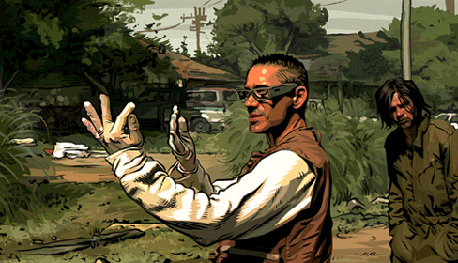Credits
Feature by: Beth Gilligan
Posted on: 17 June 2007
Related articles:
Features: What is Animation?
Dismissed by purists because it involves tracing over live-action film images rather than hand-drawing from scratch, rotoscoping is nevertheless of great historical significance within the field of animation. Max Fleischer invented the technique in 1914, and in the decades since it has been employed by animators to trace images (as in Disney’s Snow White and the Seven Dwarfs), create special effects (such as the lightsabers in the original Star Wars films), and evoke the comic-book world of a 1980s love story (as in the video for a-ha’s “Take on Me”). In Richard Linklater’s Waking Life and A Scanner Darkly, it is one of the vital, shaping forces of warped realities that unfold onscreen.

Released in 2001, Waking Life is the story of a young man who floats from one conversation to the next, unsure if he is dreaming or conscious. While some of the people he speaks with spout dense philosophical theories, other encounters are wholly nonsensical, and all are tinged with an absurdity that is heightened by the movie’s distinct visual style. One of the trademark qualities of rotoscoping is the shaky appearance it often produces as a result of the lines that have been traced over deviating from frame to frame. In Waking Life (as in A Scanner Darkly), this wavering seems wholly appropriate given the lead character’s own uncertainty towards his state of consciousness.
Linklater’s decision to use rotoscoping technology also allows for certain visual exaggerations to occur within the frames. For instance, as the young man listens to a treatise on evolution, a couple of fish with legs can be witnessed strolling along in the tank behind the speaker. In another scene, two men engaged in a deep discussion about how André Bazin applied his Christian beliefs to film theory are suddenly transformed into cloud-like figures. Throughout the movie, the lead character and others can be seen floating through the air. In some scenes, he appears to be consciously aware of the fact that he’s dreaming, a paradoxical state perfectly encapsulated by rotoscoping’s integration of filmed and animated reality.
Though none of the action that occurs in Waking Life is linked by a cohesive narrative thread, each encounter is distinguished by a somewhat distinctive visual style. Unlike in A Scanner Darkly, where he was to insist on a uniform look, here Linklater employed different artists to illustrate different scenes and allowed them a certain degree of expressiveness within each one. As a result, each of the young dreamer’s encounters has a unique feel, all of which suggest a different degree of consciousness on his part.

A Scanner Darkly is in no way, however, stultified by its relative uniformity of image; if anything, the consistency of the animation onscreen underlines the utter conformity of the veritable police state depicted in the movie. Released five years after Waking Life and set seven years in the future, it is based on a novel by Philip K. Dick, and as such is more plot-driven than the former film (though again, this is in relative terms). The story revolves around Bob Arctor (played by Keanu Reeves), a.k.a. “Fred,” an undercover cop who has become addicted to a dangerous drug called Substance D while on assignment to monitor fellow users. As he stumbles further down the path of addiction, Arctor begins to — quite literally — lose his sense of self.
In several scenes, Arctor is depicted wearing a “scramble suit” to protect his identity. In Dick’s novel, those who wear the suits are described as being transformed into a “vague blur,” but in Linklater’s film, one can glimpse several faces overlapping each other so as to make it impossible to discern the identity — or even gender — of the person inside it. The suits not only stand out as one of the most technically inventive results of the rotoscoping process as utilized by Linklater, but they also work as a potent metaphor for the fluid nature of identity and reality as depicted in the film. The casting of three actors (Winona Ryder, Woody Harrelson, and Robert Downey, Jr.) who have made tabloid headlines for their involvement in drug-related scandals lends an added sense of surrealism to the proceedings.
As such, rotoscoping itself seems like an especially appropriate choice here as it, like Arctor, is stranded somewhere between real and artificial images. As in Waking Life, the animators are given a certain amount of free reign to create hallucinatory scenarios for the characters to endure (e.g. two of Arctor’s companions are suddenly transformed into Kafkaesque bugs, and one character’s suicide attempt leads to a confrontation with a no-nonsense alien), but the film is most unsettling in its depiction of a world not too far removed from the one we live in. With the help of rotoscoping technology, Linklater has rendered a dystopian nightmare that, despite being animated, feels eerily realistic.
We don’t do comments anymore, but you may contact us here or find us on Twitter or Facebook.



